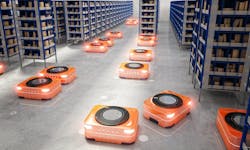The mobile robot market is set for a major transformation over the next decade as autonomous mobile robots (AMRs) get widely adopted in warehouses and logistics centers following years of pilots stages.
The industry is now growing rapidly as the technology hits the mainstream driven by an acute labor shortage and eCommerce boom coupled with increasing customer demands for faster and cheaper delivery and high return rates.
Furthermore, recent events have caused a “tipping point” as to AMRs being used to support order fulfillment, according to Interact Analysis.
According to new research from Interact Analysis, the acquisition of Kiva Systems by Amazon, and its subsequent dominance of online retailing through heavy adoption of robotics and automation has triggered two significant trends in the industry. First, it led to the emergence of dozens of robotics start-ups to fill the vacuum that Kiva left behind. Second, it has forced retailers and logistics companies to adopt automation to keep pace with Amazon.
The research findings show that, excluding Amazon, more than 100,000 AMRs will have been deployed for order fulfillment by the end of 2020, and that more than 580,000 will be installed over the next five years.
Although fewer than 300 sites had order fulfillment AMRs deployed at the end of last year, explosive growth is predicted due to the ‘perfect storm’ of a number of key drivers. The report highlights the 'Amazon Effect', whereby e-commerce companies are being forced to increase speed and flexibility of operation in order to keep up.
Record low unemployment rates, coupled with the on-going shift of younger generations away from manual labor, have also created a major shortage of warehouse workers, increasing demand for automated systems. The speed with which the technology has matured and moved beyond the early adopter stage has made deployment an increasingly attractive option.
“With Amazon deploying Kiva’s goods-to-person approach for order fulfillment, it’s easy to see why others like GreyOrange, Geek+ and Quicktron have followed in its footsteps, and arguably have seen greatest success so far,” Ash Sharma, research director at Interact Analysis said in a statement.
“Despite this, AMR vendors have emerged with a variety of different approaches and sub-approaches. The question over which technology or approach will ‘win’ is not an easy one to answer. All approaches are forecast for strong growth (albeit at different paces and timeframes), and the approach preferred will depend on a number of variables.
“While in every industry there are always winners and losers, right now it appears that the size of the untapped opportunity and the underlying drivers of demand are more than strong enough to support all the vendor types we see today, and as a result we expect very promising growth for the majority.”
